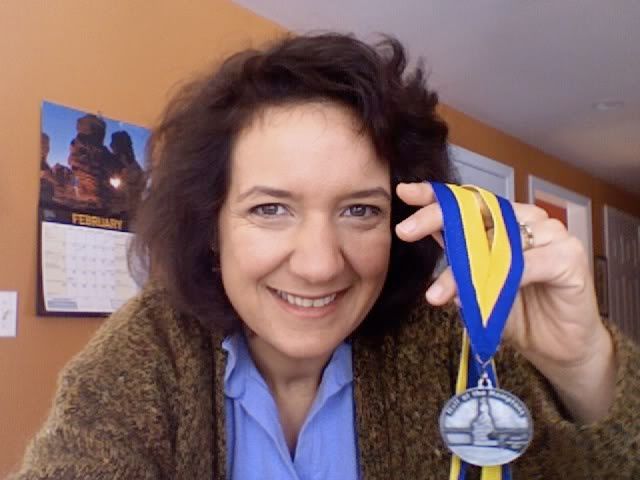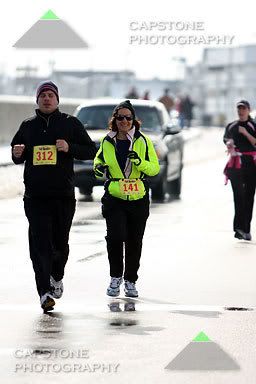My Half at the Hamptons was a good experience, but not necessarily one I wish to repeat. It wasn't the running, it was the cold, wind, snow, sleet and freezing rain that got me.
Starting out:
0.8 miles down,
12.3 miles left to go...!
0.8 miles down,
12.3 miles left to go...!
I ran a 10 minute/mile pace for a while, but after a couple miles I had to walk for a minute and drink a lot of water. I had a horrific pain in my right side and under my ribs. I tried kneading it, stretching, breathing deeper, and drinking water. It took three miles, but I finally shook it off. It was horrible!
Despite the horrific pain in my side,
I have a happy smile going here.
I'm so glad to be doing my 2nd half marathon!
I have a happy smile going here.
I'm so glad to be doing my 2nd half marathon!
I maintained a decent pace, though. I was trying to keep the 11 min/mile pacesetter in sight; it wasn't until mile 8 that I heard from other people that no, I wasn't imagining it--he was running more like a 10-minute-mile pace. I had thought so, but I kept wondering if he was starting out fast to "bank" time for slowing down later. Or maybe he was just not a great pacesetter! Eventually I passed him, and ended up finishing before he did.
I got too warm, despite the cold weather,
and had to undo some layers. You can see
my water bottle in my right hand--
I was still trying to shake that side pain.
and had to undo some layers. You can see
my water bottle in my right hand--
I was still trying to shake that side pain.
Eventually, I slowed way down as the cold and weather started bogging me down. It was tough slogging, with the precipitation kicking in around mile 6, then the freezing rain literally bogging down my running pants so that I had to keep hiking them up around my waist as I ran. My drawstring was broken so that was no help.
The last couple miles were especially tough, with the wind whipping straight into our faces and straight through my soaking pants. Running into a headwind is bad enough; doing it when wet and trying to speed up during the last bit is near impossible. I eventually managed to force myself to manage a pathetic kick at the end, and finished in 2:22:39, knocking a good 14+ minutes off my first half marathon time (which was run in perfect conditions, no wind).

A couple days later, with my finishers medal.
I still cannot figure out what the figure in the center
is supposed to represent.
To me, it looks like a 1920s flapper
sitting on a pile of boxes and bags from a shopping spree!
I was really happy with my performance, and was lucky in that Kent and the girls happened to drive by (looking for parking) right as I raced across the finish line. So they saw me finish! However, when I stopped to take my timing chip off my shoe, my stomach hurt so badly, I felt so sick and nauseous, but not like I had to throw up. I just needed some nutrition and DESPERATELY needed to stretch. I spent 20 or 30 minutes chatting with Amy and her family, and stretching out the body, while enjoying an Accelerade and some of my favorite Stacy's Pita Chips, which LocoRunning always seems to provide.
Oh, and of course, the requisite banana.
Some time later, "Auntie Sue" (the girls' Godmother and our dear friend) told me that all that sick feeling was probably a bit of hypothermia; all the blood was being shunted to major organs to prevent me from going into cold shutdown, but at the same time I was trying to force it into extremities with the running. She said running this was no doubt a good experience and a great challenge, but not something I should consider repeating because of the hypothermia dangers.
I told her, Not to worry--I am DONE with running half marathons in New England in FEBRUARY! If I run another February half marathon, it's going to be someplace like Sedona or Hawaii! I am not THAT addicted to running that I'm willing to do that again.
The sad part is that a runner, Bill Paradis, died on the course--a man from North Berwick. I passed the ambulance at mile 6, and the women he was with were crying. The papers later said they rushed him to the hospital, but I saw his sneakers sticking out of the end of the gurney inside the ambulance, and NOBODY was rushing anywhere. I'm sure he was already gone (massive heart attack) and the "rushing to the hospital" to pronounce was a formality. It was very very sad.
Apparently he was a pretty nice man, an oustanding member of the running community, and was a supporter of Olympic Marathon hopeful Emily LeVan (http://www.twotrials.org), who is trying to qualify while her 5 year old daughter Maddie is simultaneously battling leukemia.
Bill Paradis will be much missed by the seacoast community.
___________________________________________________________________
Anyway, with that said, now I am going to veer into another direction. As promised, I need to address the issue of winter running--not that we'll be doing much more of that (hopefully).
When it comes to clothing, it's all about the layers. You need to be comfortable--not too hot, and definitely not too cold. You need something that wicks away sweat, so it doesn't get cold and clammy (or worse yet, freeze to you).
So what is layering? Basically, it's putting two or more pieces of clothing over each other to help you keep dry and warm when you're out in the elements. Then, as you get warm or cold, you can add to or "delete" items from your attire.
"The Layers"
The first layer you want up next to your skin is the wicking inner layer. That is the layer of clothing that will trap warm air against your body, but it will also transfer, or "wick", away the moisture you produce when you exercise. You know--sweat. You can use anything made of polypropolene or microfleece. I like coolmax products, and others like Power Dry underwear. Under Armour makes good stuff too. You'll see it on the label.
The second or middle layer needs to be for warmth. Its purpose is to insulate the body, to help you retain heat. Wool is a great option, unless it makes you itch. My preference is fleece, but you can also use down or primaloft (depending on conditions). Sweaters, jackets, vests--all are good options.
The third or outer layer is for protection from the weather. This is the layer that's going to keep that rain, snow and sleet out--or, in the case of me during my last half marathon, the layer that DIDN'T keep the rain, snow and sleet out. Some good choices include gore-tex shells (which are waterproof), nylon shells (which are water resistant, unless you treat them with some waterproofing option), and insulated jackets or parkas. My Brooks Nightlife shell (the bright yellow one) was actually quite effective; it was only the Sporthill running pants that I had on that weren't weather-resistant, and that bogged down.
Of course, you will probably want some sort of weather resistant and warm hat, and the same with the gloves, and maybe even something to wear over your face if it's cold enough.
There you have it. The three layers that keep you toasty.
The last thing you need to know when you go out is that all this clothing should NOT make you feel toasty as you run out the front door. If that's the case, you'll be overheated before you hit the first mile-marker.
Ideally, you should feel somewhat chilled when you first start out. You'll warm up as you go, and then you'll be good for the run.
As far as wind, if you have to run in windy conditions, and you have any choice, it's best to run into the wind on the way out, then with the wind on the way back. That way the wind won't be chilling you all the way home when you're at your sweatiest.
Some people love to run in winter. As for me, I have learned to love my treadmill. If it weren't for the fact that I wanted to keep my fitness level or improve, I wouldn't have worried about running at all. I HATE the cold.
So what am I doing living in Maine?? Hee hee! Ask me next summer and fall when the weather here is glorious!
I hear a baby crying out for her Mom. Time to hit the road.
Be well!
"You gain strength, courage, and confidence by every experience in which you stop to look fear in the face."
- Eleanor Roosevelt
____________________________________________________________________________
Disclaimer: Look, I'm not a doctor. However, I am a teacher certified in both California and Maine to teach science curriculum, including the human body (and health/nutrition) to kids in grades K-8. This blog is my attempt to wade through the current thinking on weight loss, and to present it in a way that makes sense to everyone. As a woman who is successfully recovering from obesity herself, I feel it's even more important to help others understand what I did to lose the weight; what worked, what didn't, and what the struggle has been like as I went from morbid obesity to fitness. It doesn't mean that I have all the answers, however. If you want to lose weight, by all means, read my blog--I think I can provide some help and clarity. BUT, please know that I am NOT a medical expert, and you should most definitely consult with your own doctor or family physician before undertaking any weight loss efforts yourself. Weight loss is a personal journey. I'm making mine visible to the world, but each of us has to take our own steps with our own doctor's guidance; please make sure you check in with yours before you try to do anything I have done. Good luck and God bless!


